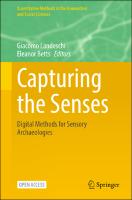Capturing the Senses
Digital Methods for Sensory Archaeologies
| dc.contributor.editor | Landeschi, Giacomo | |
| dc.contributor.editor | Betts, Eleanor | |
| dc.date.accessioned | 2023-06-20T10:23:32Z | |
| dc.date.available | 2023-06-20T10:23:32Z | |
| dc.date.issued | 2023 | |
| dc.identifier | ONIX_20230620_9783031231339_9 | |
| dc.identifier.uri | https://library.oapen.org/handle/20.500.12657/63546 | |
| dc.description.abstract | This open-access book surveys how digital technology can contribute effectively to improving our understanding of the past, through a sensory engagement based on the evidence of material culture. In particular, it encourages specialists to consider senses and human agency as important factors in studying ancient space, while recognising the role played by digital tools in enhancing a human-centred form of analysis. Significant advances in archaeological computing, digital methods, and sensory approaches have led archaeologists to rethink strategies and methods for creating narratives of the past. Recent progress in data visualisation and implementation, as well as other nascent digital sensory methods, means that it is now easier to explore and experience ancient space from a multiscalar perspective, from the individual body or single building to the wider landscape. The chapters in Capturing the Senses: Digital Methods for Sensory Archaeologies present innovative methods for representing an embodied experience of ancient space, simulating (but not recreating) ancient behaviours and social interaction. Chapters cover topics including the potentials and pitfalls of visualising, recreating, and re-enacting/experiencing the senses in Virtual Reality environments and also digital reconstructions and auralisations of ancient spaces to study sound sensory perception. Overall, the book demonstrates that multisensory approaches can give a new perspective on how ancient spaces were intended to be used by inhabitants to fulfil a series of purposes including conveying messages and regulating movement. This is an open-access book. | |
| dc.language | English | |
| dc.relation.ispartofseries | Quantitative Methods in the Humanities and Social Sciences | |
| dc.subject.classification | thema EDItEUR::J Society and Social Sciences::JH Sociology and anthropology::JHB Sociology::JHBC Social research and statistics | en_US |
| dc.subject.classification | thema EDItEUR::N History and Archaeology::NK Archaeology | en_US |
| dc.subject.classification | thema EDItEUR::J Society and Social Sciences | en_US |
| dc.subject.other | Sensory Studies | |
| dc.subject.other | Sensory Archaeology | |
| dc.subject.other | Digital Humanities | |
| dc.subject.other | Human Geography | |
| dc.subject.other | Landscape Archaeology | |
| dc.subject.other | Phenomenological Archaeology | |
| dc.subject.other | Multisensory | |
| dc.subject.other | Cultural Heritage | |
| dc.subject.other | Spatial Analysis | |
| dc.subject.other | Data Visualization | |
| dc.subject.other | Digital Media | |
| dc.subject.other | Digital Epigraphy | |
| dc.subject.other | Heuristics | |
| dc.title | Capturing the Senses | |
| dc.title.alternative | Digital Methods for Sensory Archaeologies | |
| dc.type | book | |
| oapen.identifier.doi | 10.1007/978-3-031-23133-9 | |
| oapen.relation.isPublishedBy | 6c6992af-b843-4f46-859c-f6e9998e40d5 | |
| oapen.relation.isFundedBy | e1fe024a-4f5f-4dab-8dfa-f2758fa64b0b | |
| oapen.relation.isbn | 9783031231339 | |
| oapen.relation.isbn | 9783031231322 | |
| oapen.imprint | Springer International Publishing | |
| oapen.pages | 264 | |
| oapen.place.publication | Cham | |
| oapen.grant.number | [...] |

